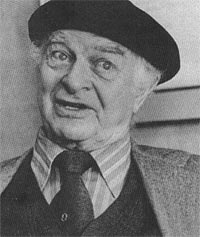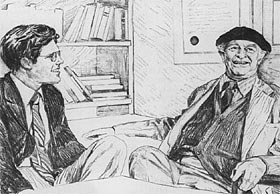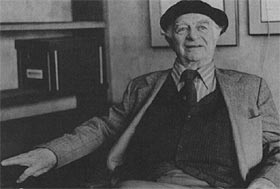Interview: Linus Pauling

Linus Pauling has helped to define modern biology by applying physical and chemical principles to the study of life. Pauling earned a Ph.D. in chemistry from the California Institute of Technology in 1925, at the age of 24. After studying with some of the leading physicists in Europe, Pauling returned to Cal Tech and published a series of papers on chemical bonding that eventually led to the Nobel Prize in chemistry in 1954. By that time, Pauling had already begun to apply his knowledge of physics and chemistry to the study of biological molecules. Among the many important contributions he has made to biochemistry are the description of factors that determine the structure of proteins and the discovery of the molecular basis of sickle-cell anemia, an inherited disease. Pauling also became the scientific community's leading advocate for halting the testing of nuclear weapons, and in 1963 he received the Nobel Peace Prize for efforts that helped produce a testing ban. (Pauling is the only recipient of two unshared Nobel Prizes.) In this era of narrow specialization, Linus Pauling stands out for the breadth of his contributions.
In the following interview, Dr. Pauling enunciates a major theme of biology when he discusses the futility of trying to draw a sharp boundary between an assortment of nonliving chemicals and the life that arises from interactions between those chemicals. It has been said that a human consists of only a few dollars' worth of chemical elements; it is the ordering of those ingredients into higher levels of structural organization that makes a living organism. This unit of chapters reduces living matter to its chemical components, but builds on the theme that it is in the integration of those components that the properties of life emerge.
Dr. Pauling, how would you answer a student who asks why the modern biology curriculum includes so much chemistry?
Well, biology is moving in the direction of chemistry. Much of the understanding of biology that exists now is based on the structure of molecules and the properties of molecules in relation to their structure. If you have that basis, then biology isn't just a collection of disconnected facts. Arid chemistry itself has changed in the last 60 years from being largely a collection of disconnected facts to being a science with a good theoretical or structural basis.
Just as we can understand some of the properties of living organisms in terms of the molecules that make up those organisms, so can we understand the properties of molecules in terms of the atoms that make them up and in terms of the way the atoms are connected in the molecule.
After beginning your scientific career as a chemist, what attracted you to biology?
I wanted to understand the world. Back in about 1919, when I began thinking about problems and devoting more and more of my time to trying to understand the world, I was forced to study molecules with relatively simple structure. So in 1922, when I started my graduate work, I began using the technique of X-ray diffraction to determine the structures for crystals of simple inorganic compounds: minerals. By 1930 I had become interested in applying the same techniques to organic compounds, relatively simple ones with five or ten atoms in the molecule.
By 1935 I was ready to progress to the larger organic molecules that are characteristic of living organisms. It was hemoglobin, the oxygen-carrying protein of blood, that I first worked on. The hemoglobin molecule has about 10,000 atoms. My work with proteins and amino acids led to my interest in the molecular aspects of medical problems: sickle-cell anemia and other hereditary disorders, and mental disease. Later, I became interested in the vitamins; that's my present phase.
Among some chemists and physicists, biology has a reputation for being a rather inexact science. Is biology beginning to lose this image?
Oh, yes! The whole field of molecular biology, which one might say is modern biology, has developed since I was a student. But, of course, the change began even before the development of ideas of molecular structure. Genetics was, I would say, the first area of biology to become a pretty good theoretical subject, based on the theory of the gene and patterns of inheritance of characteristics. This, of course, has become more refined in recent years and has been extended by the discovery of the structure of DNA. Besides inheritance, many other biological phenomena can now be discussed in a quantitative way. Yet there is still a very large empirical component to biology. I suppose this empirical component will exist into the distant future, because living organisms are so extremely complicated.

So complicated that a standard procedure for biochemists is to grind up cells to isolate specific structures or molecules in order to study them under conditions simpler than those existing in the intact cell or organism. To what extent can we understand life by breaking it down, in contrast to trying to study processes in whole cells or organisms?
I think you have to do both. Life is too complicated to permit a complete understanding through the study of whole organisms. Only by simplifying the problem, breaking it down into a multitude of individual problems, can you get the answers.
In 1935 Dr. Charles Coryell and I made our discovery about how oxygen molecules are attached to the iron atoms of hemoglobin, not by getting a cow and putting it into our magnetic apparatus, but by getting some blood from the cow and studying this blood. We made some measurements on the blood, but we also separated the red cells from the blood and broke them so that we could make measurements on their contents. We got the same answer from measuring the hemoglobin solution, essentially the red cell contents, as we had obtained by making similar measurements on the whole blood taken from the cow.
Of course, the study of different parts of an organism leads to the question, Do these parts interact? Can we learn more about the living organism by putting two parts together to see to what extent the properties of the combination are different from those of the two separated parts? This approach permits further progress in understanding the organism. And yet I myself have confidence that all of the properties of living organisms could ultimately be discovered by this process of attempting to reduce the organism in our minds to a combination of the different parts: essentially, the molecules that make up the organism.
Your last point raises another question: If living organisms are made of lifeless molecules, then where is the dividing line between a molecular aggregate and life?
Perhaps I shouldn't let your question go by without challenging the expression "lifeless molecules." This is just a matter of words. I can ask, if I crystallize a virus to obtain a crystal consisting of the molecules that make up the virus, are those molecules lifeless or not?
Put in those terms, it's a rather arbitrary line, isn't it?
That's right! It's quite arbitrary. The properties of living organisms are those of aggregates of molecules. There may well be some point at which one tries to draw a dividing line. But it's very difficult to draw such a line between molecules that are lifeless and molecular aggregates that are not lifeless.
In a world with over 90 chemical elements, why are just a few — particularly carbon, oxygen, hydrogen, and nitrogen — so prevalent in the architecture of biological molecules?
Well, it is possible with these elements, especially carbon, to form very large molecules that are stable. This results from the stability of the carbon-to-carbon bond. You must have complexity to achieve the versatility characteristic of living organisms. You can achieve this complexity with carbon forming the molecular backbone or with silicon forming the backbone. I think there might well be, as many science fiction writers have pointed out, planets with living organisms based on silicon. One science fiction story imagined a process, analogous to respiration, that turned out bricks made of silicon dioxide as a waste product.
You were a pioneer in the study of life's most complex molecules, the proteins. Today a great deal is known about the structure and function of proteins and other giant molecules found in living organisms. Are you at all surprised at how fast and far molecular biology has come in the past few decades?

It's gone along faster than I expected. In fact, I began trying to find the structure of proteins in 1937 and didn't succeed. So I began working with my collaborators to determine the three-dimensional structures of amino acids and simple peptides. In 1937 no one had yet determined such structures for any amino acid or simple peptide. By 1948 a dozen or more had been determined, all of them in our laboratory in Pasadena. And then in 1948, of course, I found the a helix and pleated sheet structures in proteins.
At that time I realized that nothing new in the field of structural chemistry had been turned up during our studies. I could just as well have found these structures in 1937. I'm surprised that nobody else had done this job in the 11 years that intervened — in a sense, surprised that I hadn't done it in '37, when my ideas were all the right ones. I just hadn't worked hard enough.
Of course, you don't know how hard a problem is until it has been solved. You don't know that you will succeed if you work harder or longer on the problem. You may just give up, thinking that it's too hard a problem. So I can understand, sometimes, that progress is slow. But then, of course, there does come a time when a lot of people accept some new idea and see ways in which it can be exploited. And because of the larger number of workers in the field, progress is rapid. That is what happened with the study of protein structure. There are more than three hundred protein molecules whose structures have been determined in detail now, giving much insight into the properties of proteins.
During your career, Dr. Pauling, you have redirected your research interests many times, anticipating the way biology was moving and contributing to those changes in direction. As you look ahead, can you foresee any new questions about the chemistry of life that may redirect your interests still another time?
I suppose if I knew the answer, I'd change my interests now! I've tried to fit knowledge that I acquired into my understanding of the world. And much of the new information that I learned, discoveries that have been made, seemed to me to be compatible with my existing understanding of the world. When something comes along that I don't understand, that I can't fit in, that bothers me. I think about it, mull over it, and perhaps ultimately do some work with it. And that's perhaps the reason I was able to make discoveries in molecular biology, for example, in the early days when the subject didn't exist.
Often, I'm not very interested in something new that's been discovered, because even though it's new, it doesn't surprise me. It just fits in. It's the things that I don't understand that surprise me and interest me. For example, I was, for about ten years, a member of the scientific advisory board at Massachusetts General Hospital. One day, in about 1952, Professor Henry K. Beecher gave a talk on anesthesia. He said that the inert gas xenon had been used as a general anesthetic in two operations on humans. I said to my son, who was a medical student there, "How can xenon, which is chemically inert, be an anesthetic agent?" I thought about that, and in '59 I published my paper on a theory of general anesthesia. So, the fact that I couldn't understand why xenon would act as a general anesthetic agent led me to these ideas.
Dr. Pauling, if I understood you correctly earlier, you said that you were confident that the day will come when we will have a fairly complete understanding of life at the molecular level. Do you think that level of understanding will limit further inquiry?
No, I don't think so. Some scientists have thought that the time might come when living would be just a big bore. I don't think that will ever happen. I think there will always be something interesting remaining to be discovered.
©2005 Pearson Education, Inc., publishing as Benjamin Cummings